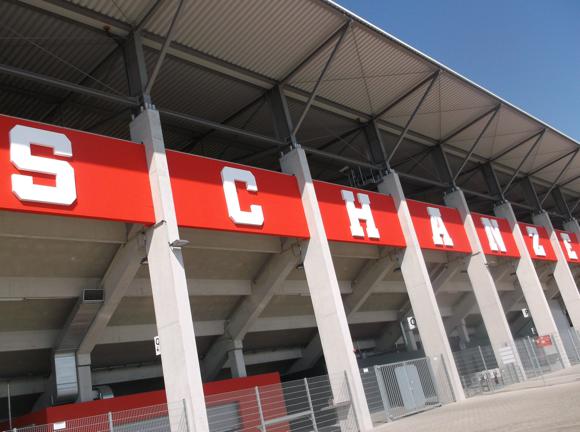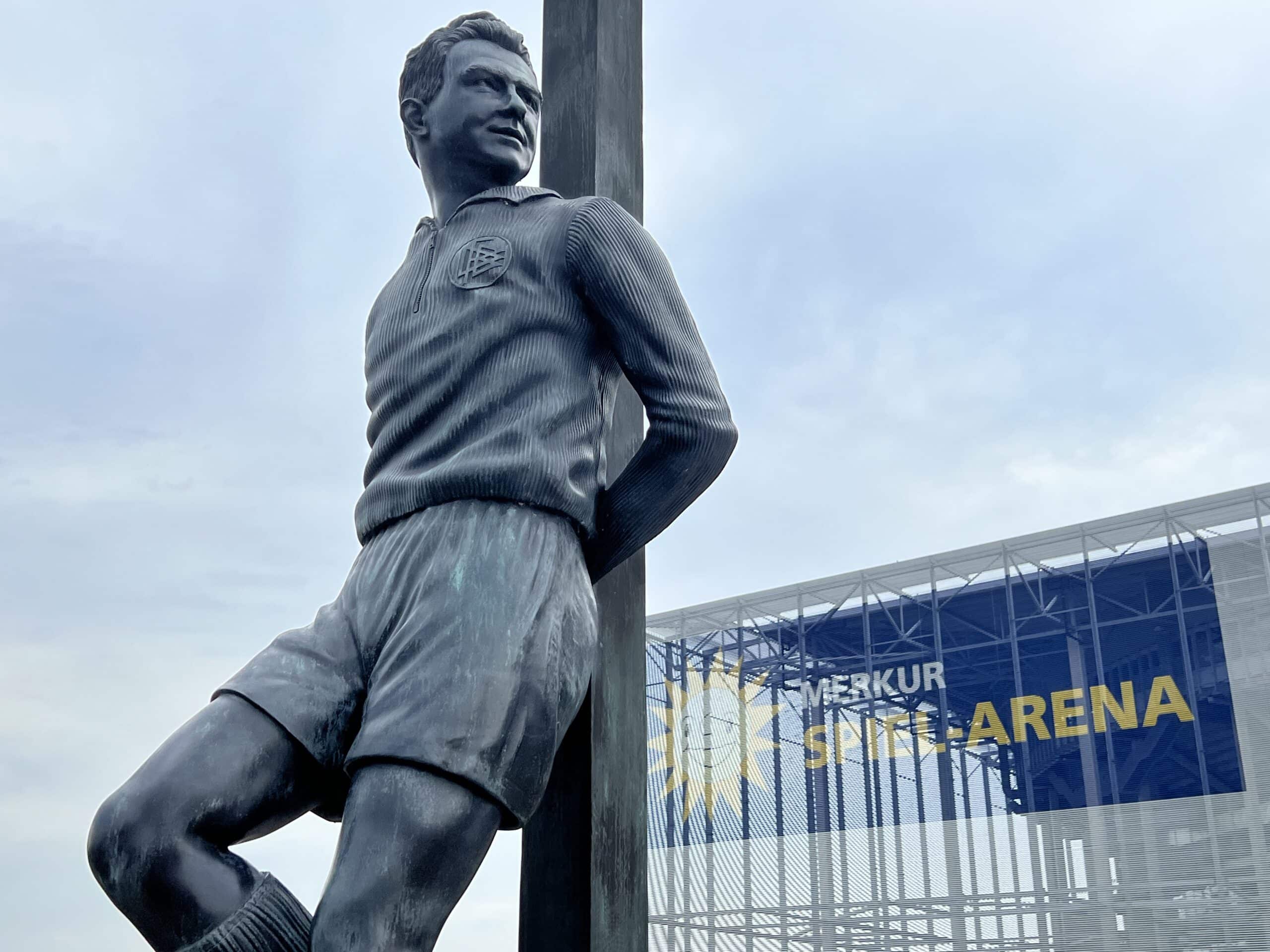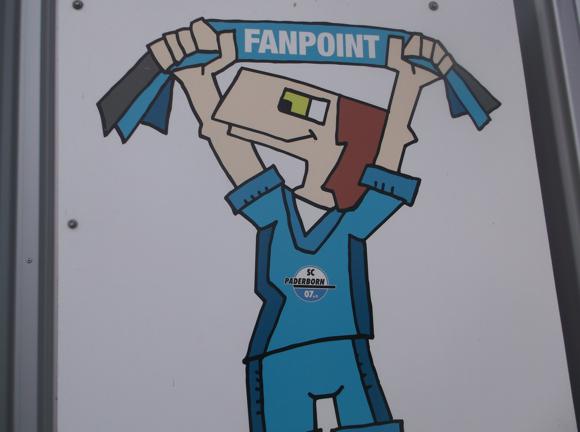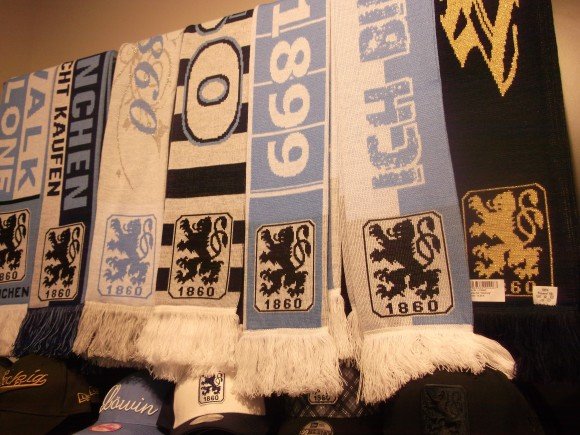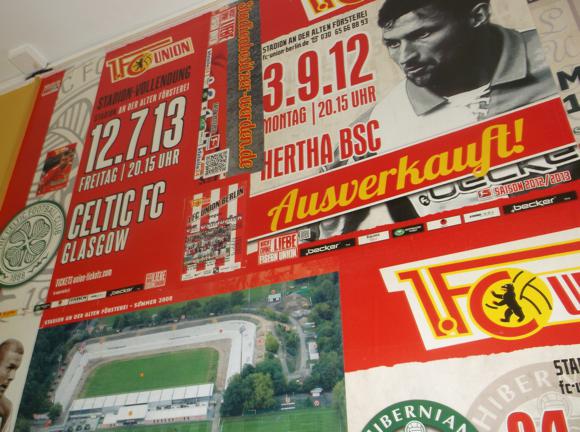A fan’s guide – the club from early doors to today
After a century-long transformation from village factory team to international contenders, Bayer Leverkusen won a (very) long-awaited Bundesliga title in 2024. After decades of having to live with the tag of ‘Neverkusen’, particularly related to the 2002 treble bid that ended in heroic failure on three fronts.
That all changed with the arrival of Xabi Alonso as coach in October 2022, ostensibly to lift the club out of the relegation zone after decades of top-six finishes.
This he did, but his nurturing of previously unsung players – and the savvy transfer policy of chief exec Fernando Carro – then carried Bayer to the top of the table the following season. Two long winning streaks and a comprehensive 3-0 win over a wayward Bayern in February saw Alonso’s team extend the daylight between Bayer and the never-ending champions.
A tenth league victory on the bounce, 5-0 over Bremen at a buoyant BayArena in mid-April, sealed the Bundesliga crown six whole rounds before the end of the season. So often ridiculed for being backed by big pharma, in a football culture where the 50+1 rule usually prevents oligarchs from buying success, Bayer were now lauded for ending the Bavarians’ 11-year grip on the Bundesliga.



The football section of the Bayer works’ sports club, formed in 1904, played lower-league football until reaching the Oberliga West in 1951, the highest regional level before the Bundesliga was formed 12 years later. The ‘Werkself’ soon built the Ulrich-Haberland-Stadion, over the water from the sports park where the part-timers had been playing for 25 years.
While Schalke and Dortmund joined the new league in 1963, Leverkusen went to the Regionalliga. There followed a few fallow seasons before promotion, under wily old Willibert Kremer, in 1979.
Under Erich Ribbeck, the club gained a foothold in the top flight, and surprised everyone by beating Espanyol on penalties in the UEFA Cup final of 1988, clawing back a 3-0 deficit from the away leg. Star of the show was Cha Bum-Kun, whose late equaliser tied the fixture, the highlight of his near 200 games for the club.
But it was under ambitious general manager Reiner Clemunt that Bayer Leverkusen really took off. Over ten years, he had the Ulrich-Haberland converted to the BayArena, completed in 1997.



Picking up quality East Germans Ulf Kirsten and Andreas Thom, the rotund ‘Calli’ Clemunt persuaded Rüdi Völler and Bernd Schuster to join Leverkusen, who rarely failed to finish top six. The prolific Kirsten scored the only goal of the 1993 Cup Final, Leverkusen’s only domestic silverware in 25 years of near misses.
The cruellest came in 2002. With another top East German, Michael Ballack, plus Bernd Schneider, Oliver Neuville and key Brazlians Zé Roberto and Lúcio, Leverkusen were sailing to the title before Dortmund pipped them.
Ballack and company had also beaten Liverpool and Manchester United en route to the Champions League Final, decided by a wonder strike by Zinedine Zidane. Bayer even lost in the final of the German Cup, to Schalke, despite opening the scoring with rising star Dimitar Berbatov.
Ballack and Zé Roberto left for Bayern, Caimund bowed out, and Bayer trod water until Jupp Heynckes arrived as coach in 2009. Overseeing talented young striker Stefan Kießling, Heynckes steered Bayer back to a Champions League spot.



Kießling was top Bundesliga scorer as Leverkusen claimed third place in 2013, with former Bayer centre-back Sami Hyypiä taking over as coach. Sadly the Finn didn’t survive shaky run-in to the 2013-14 campaign – though fourth place was assured thanks to a 2-1 turnaround in the last game.
Bayer achieved the same under Roger Schmidt in 2014-15, Kießling still scoring but slowly succumbing to wear and tear. Almost uniquely able among German clubs to wave the chequebook, Leverkusen brought in Javier ‘Chacarito’ Hernández, having served his time at Manchester United and on loan at Real Madrid.
Exploding onto the scene in 2015, the Mexican international hit 26 goals in all competitions that season, and a healthy number the following one, but it wasn’t enough to push Bayer into European contention.
With Hernández sold on to West Ham for around £9 million more than Leverkusen had paid for him, Kai Havertz rose through the ranks to make his first-team debut at 17. By 2018-19, he was the club’s top scorer, repeating the feat the following season, helping Leverkusen maintain their incredible consistency at the business end of the Bundesliga.



It was also around this time that Fernando Carro came to the fore. An engineer trained in Germany, this Barcelona-born polyglot learned his football from Hans Krankl, the Austrian legend having been taught Spanish by Carro’s mother while he was at Barça. The pair became housemates while Carro lived in Vienna.
Picking up management skills while climbing the company ladder at German publishing giant Bertelsmann, Carro teamed up with Rudi Völler to oversee operations at Bayer Leverkusen from 2018. Between then and the game-changing arrival of Xabi Alonso in 2022, the Catalan changed the structure and working culture at the club.
The immediate effect was a run to the quarter-final in the Europa League, Havertz scoring against top defences such as Porto’s and Inter’s. He headed to Chelsea shortly afterwards, Bayer pocketing a handy £62 million. Less than half that sum was spent on attracting Patrick Schick from Roma, after the Czech international had gained a season’s worth of Bundesliga experience on loan at RB Leipzig.
It was after Schick’s sensational long-range goal against Scotland at Hampden Park, however, at the Euro finals in June 2021, that he really clicked into gear for Bayer. The club’s midfield bolstered by Robert Andrich from Union Berlin, and teenage attacker Florian Wirtz beating previous youngest-ever records recently set by Havertz for achievements, Leverkusen had a bright look about them in 2021-22.



Overpowering Celtic and Betis in Europe before falling to a talented Atalanta side in the Round of 16 of the Europa League, Leverkusen notched yet another third place in the Bundesliga to qualify for the Champions League. More of same was expected in 2022-23 but a long-term injury to Wirtz and sloppy defensive errors led to the worst start to a season since 1979.
That October, Carro and Völler replaced Gerardo Seoane with Xabi Alonso, the former Liverpool star whose previous coaching experience was leading Real Sociedad reserves to relegation. It proved a master stroke. Five straight wins in the league either side of Christmas, then again in March and April, lifted Leverkusen back into European contention for the following season.
Still in his debut campaign, although Alonso’s team had only finished in third of their tricky Champions League group, their subsequent run in the Europa League showcased the scoring prowess of the returning Wirtz. Bayer edged past Monaco on penalties and romped to victory at Union Saint-Gilloise before losing a bad-tempered semi-final against eventual champions Roma.
Despite another grim triumph for Mourinho, Bayer Leverkusen now seemed a solid proposition. A stoppage-time penalty from 2022 World Cup winner Ezequiel Palacios at Bayern gained Leverkusen a 2-2 draw against Germany’s long-term champions, the Argentine sharing scoring duties with Wirtz, Schick and Victor Boniface as Bayer swept all before them during eight straight wins that autumn.



The Nigerian international, prominent at Union Saint-Gilloise before the Belgian side ran into Bayer the previous spring, was a particular revelation. From late September, Alonso’s side never wavered from the top spot and, as Bayern faltered, many in Germany were coming to realise that the Bavarians’ 11-year grip on the Bundesliga was slipping.
In fact, with Leverkusen unblemished by defeats and scoring at will, many were willing them to win. They never let up, and by February, and a 3-0 whitewash of Bayern at the BayArena, there was only one way the title was going to go.
Alonso’s achievement was confirmed in mid-April with an emphatic 5-0 win over Werder Bremen, a Wirtz hat-trick following the striker’s excellent recent performances for the national side. It may have been a long time coming, but the scenes at the BayArena that Sunday evening will live long in the memory, and made all the more sweet by Alonso’s decision to stay at Leverkusen when the top job at his former club, Liverpool, was going begging.
In Europe, Bayer gained an enviable reputation for late, late wins when two Schick goals in stoppage time, following another he had scored at the death in Baku, put paid to a desperately unlucky Qarabag in the Europa League. Boniface then followed suit in the first leg of the quarter-final with West Ham to keep Bayer’s treble hopes alive, Alonso’s men facing Kaiserslautern in the German Cup final in Berlin.
Stadium Guide
The field of dreams – and the story behind it

Equally accommodating to business clients as to ever-increasing standing fans, the 30,000-capacity BayArena is the perfect example of how to serve a community of 160,000 people while confidently hosting the likes of Real Madrid and Manchester United on European nights.
After basic park pitches near the Bayer factory, the team ran out at Platz an der Dhünnaue, today close to Neuland-Park by the river. In 1932, Leverkusen moved to Am Stadtpark, across the stream from today’s BayArena.
With the Stadtpark packed to the rafters when Köln or Schalke came to town, the club invested in a new stadium: the Ulrich-Haberland, named after the industrial manager, then still alive, behind a Bayer share issue.
Opened in 1958 and holding 20,000, the Ulrich-Haberland served its modest purpose – until promotion in 1979. Revamping it began with the main West Stand in 1986 and continued for ten years. After the opening of a four-star hotel, the stadium was renamed the BayArena in 1998.




Capacity, though, was only 22,500. More major redevelopment was undertaken from 2008. Convertible standing terraces were installed, allowing for a 30,000 capacity for domestic fixtures but creating an all-seated arena for international games, such as the 2011 Women’s World Cup. A new roof was added, and hospitality areas increased.
Unveiled in 2009, when it hosted Germany-South Africa, the revamped BayArena was again ahead of the game. Slight modifications, such as increasing standing places for home fans to 3,000, have continued into the summer of 2013.
The main standing C sector remains at the corner of the home Nordbereich and the Ostbereich along the sidelines but is now complemented by areas across sector D and E along the whole North End.
The visitors’ sector, also with a lower standing area, remains sector G in the opposite corner, between the Südbereich behind the goal and the main Westbereich which houses the club shop and press area. The Lindner Hotel is found behind the Nordbereich.
getting here
Going to the stadium – tips and timings
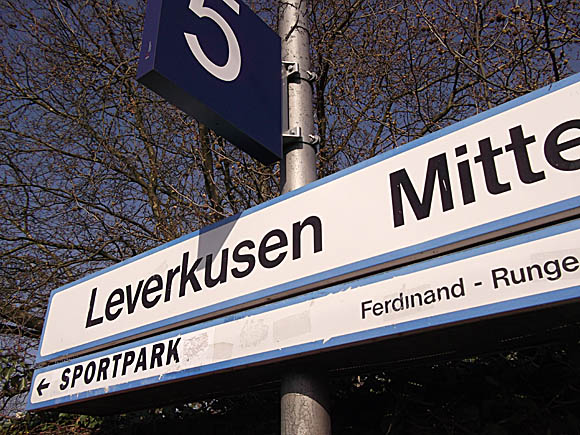
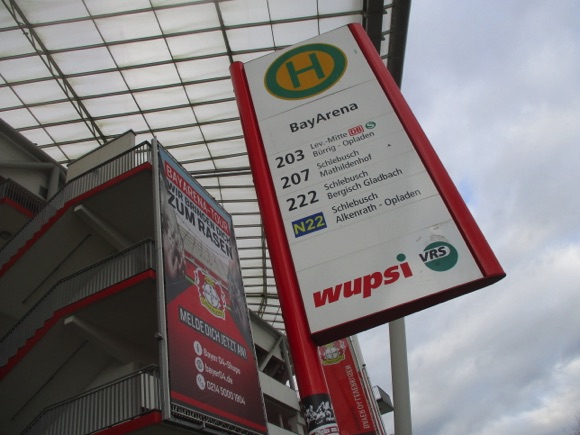

The BayArena is poorly signposted from Leverkusen Mitte station, 15-20mins from Cologne station by train or S-Bahn line 6. At Mitte, head to platform 5 and exit the station walking back parallel to the rails from the way you came. At a stream, turn right – the stadium is ahead, altogether 10mins from Mitte.
City buses serve communities around Leverkusen, match tickets valid for the journey 4hrs before kick-off. The hourly 203 runs from Leverkusen Mitte to the Sportpark Manfort stop by the stadium 7mins and five stops away.
getting in
Buying tickets – when, where, how and how much


Tickets are distributed from the Bayer 04-Shop (Tue-Fri 11am-6pm, Sat 10am-2pm, 2hrs before kick-off) near the Lindner Hotel. Ticket windows are behind the Ostbereich, by main Bismarckstraße behind the stadium.
There is also an online service. Prices vary according to the opposition. Against lesser teams, you can find tickets for €16 in the corners and behind the goals, €23-€26 everywhere else, €32-€37 for a better class of visiting team, when it’s €20-€26 in the corners and behind the goal.
what to buy
Shirts, souvenirs and gifts – plus opening hours







There are two Bayer 04 Shops, one behind the Nordbereich at the BayArena (Mon-Fri 10am-5pm & match days) and a City one (Mon-Sat 10am-7.04pm) in town at Wiesdorfer Platz 9, close to Leverkusen Mitte station, its closing time corresponding to the iconic year of 1904.
Carrying on a long recipe tradition, Bayer produce their own cookbook, 3D BayArena puzzles, and T-shirts showing the Leverkusen cityscape with the stadium and Bayer factory prominent. No branded aspirins, sadly.
It’s also worth popping into the excellent Fanbetreuung Bayer 04 Leverkusen (Breidenbachstraße 46, Tue-Thur 10am-5pm, Fri 10am-2pm), a clubhouse for Bayer supporter associations, where you can always pick up a badge or scarf. The club’s Fanprojekt (Tue-Thur 10am-5pm, Fri 10am-2pm) is nearby at Lichstraße 64, with activities for young followers of Bayer.
Stadium tours
Explore the ground inside and out


The Classic-Tour (€9/€5 3-14s) is bookable for Wed & Fri 3pm & 6pm, Sat 1pm and Sun 11am except on match days. Visitors should meet at the Bayer-04 Shop behind the Nordbereich 15mins beforehand. Book through info@bayer04.de.
Where to Drink
Pre-match beers for fans and casual visitors






Along Bismarckstraße as you approach the BayArena, American-style Arizona shows match action and serves grilled dishes and cocktails, in the former location of Havana where Ballack and co used to celebrate in the late 1990s. Alongside, the elegant Haus am Park operates only at meal times, and elegant, pricy terrace restaurant hardly suitable for pre-match imbibing despite its proximity to the stadium.
On the same street just the other side of the stadium, Stadioneck is run by the Nordkurve faithful on match days, when a special beer is selected, and for Bayer-themed events. The tokens for the deposit on bottles are collectable – or totalled up and given to charity. Behind the bar on Karl-Marx-Straße, the Stadion Büdchen is a stehcafé dealing with the overflow on match days.






The other option is the Bar Winners’ Place at the Lindner Hotel built into the north end of the stadium – although the actual bar operation doesn’t get going until 6pm, before which, it’s a restaurant serving hot and soft drinks. Plenty of screens, though.
Open 2hrs before kick-off and from 3pm for evening games, Schwadbud on the east side of the stadium on Bismarckstraße welcomes all match-ticket holders with beer and 24 screens. Match shirts from Bayer’s two European finals deck the walls, along with archive photos from the early days. You can’t reserve a table, it’s first-come-first-served for the 250 places.














